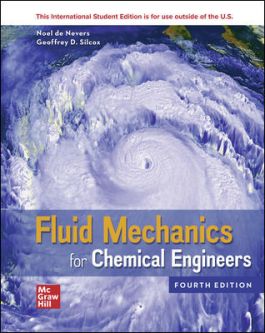Fluid Mechanics for Chemical Engineers ISE
4th Edition
1260590585
·
9781260590586
© 2021 | Published: January 14, 2020
The 4th edition of Fluid Mechanics for Chemical Engineers retains the qualities that have made earlier editions popular. It is readable, accessible, and filled with intriguing examples and problems that bring the material to life. Many of the example…
Read More
After you purchase your eBook, you will need to download VitalSource Bookshelf, a free app. Then login or create an account and enter the code from your order confirmation email to access your eBook.
- Note: the eBook does not include access to Connect
- Access the eBook anytime, anywhere: online or offline
- Create notes, flashcards and make annotations while you study
- Full searchable content: quickly find the answers you are looking for
1 Introduction
Part I Preliminaries
2 Fluid Statics
3 The Balance Equation and the Mass Balance
4 The First Law of Thermodynamics
Part II Flows of Fluids that are One-Dimensional, or that can be Treated as if they were
5 Bernoulli's Equation
6 Fluid Friction in Steady One-Dimensional Flow
7 The Momentum Balance
8 One-Dimensional High-Velocity Gas Flow
Part III Some Other Topics that can be Viewed by the Methods of One-Dimensional Fluid Mechanics
9 Models, Dimensional Analysis, and Dimensionless Numbers
10 Pumps, Compressors, and Turbines
11 Flow Through Porous Media
12 Gas-Liquid Flow
13 Non-Newtonian Fluid Flow in Circular Pipes
14 Surface Forces
Part IV Two- and Three-Dimensional Fluid Mechanics
15 Multidimensional Fluid Mechanics
16 Potential Flow
17 The Boundary Layer
18 Turbulence
19 Mixing
20 Computational Fluid Dynamics (CFD)
21 Microfluidics
Appendix A Tables and Charts of Fluid Properties, Pipe Dimensions and Flows, and High-Velocity Gas Flows
Appendix B Derivations and Proofs
Appendix C Answers to Selected Problems
The 4th edition of Fluid Mechanics for Chemical Engineers retains the qualities that have made earlier editions popular. It is readable, accessible, and filled with intriguing examples and problems that bring the material to life. Many of the examples are based on household items that students can observe every day. Some of the new material that has been added includes wind turbines, hydraulic fracturing, and microfluidics.

